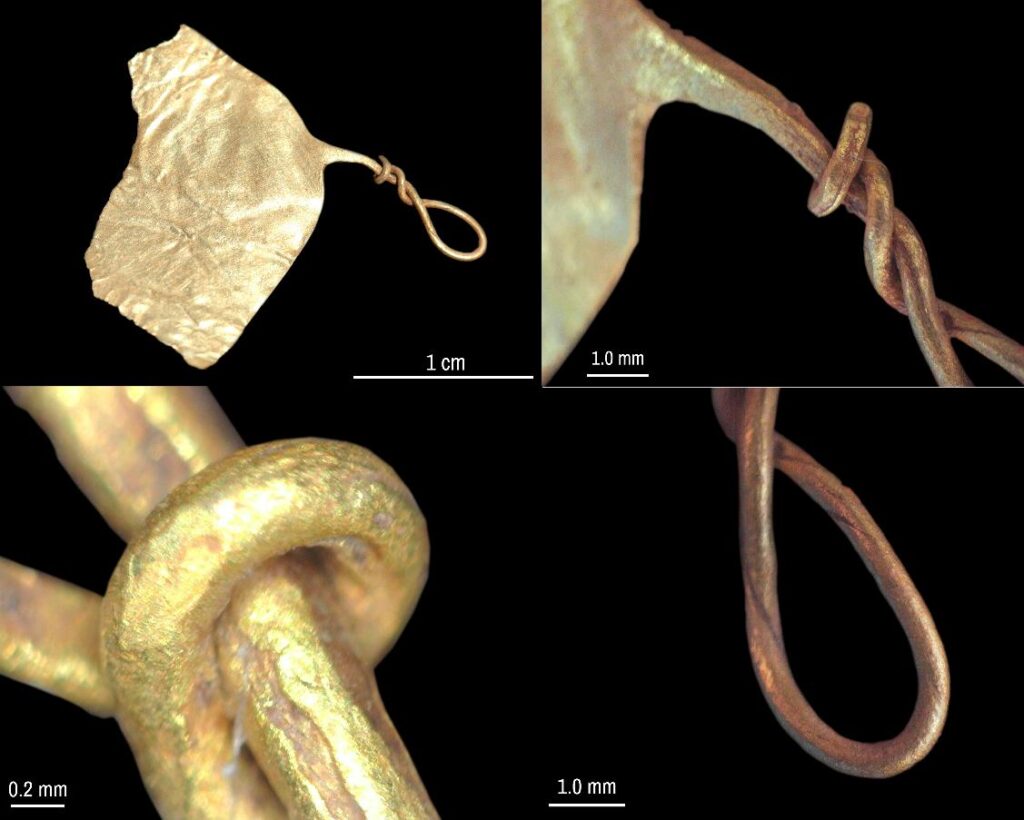The meticulous excavations at Sissi have uncovered a total of 46 gold items that hold significant value for understanding the role of gold in Cretan Bronze Age society.
The majority of the gold items come from two different pivotal moments in Sissi’s history that coincide with major changes in Cretan history. The first group originated from the Pre- and Protopalatial cemetery; the second a group includes beads from the LM II shaft grave tomb. Additional items were recovered from several other places across the site.
The artefacts were examined for manufacturing and use-wear traits using a Dino-Lite digital microscope, and analysed for elemental composition using an Olympus Vanta VMR portable X-ray fluorescence spectrometer (pXRF) calibrated for gold alloys.
The Prepalatial and Protopalatial items are small and in general can be divided into two categories. Gold sheets have been identified as fragments of larger artefacts, from which they most likely were deliberately cut or ripped. With few exceptions, the manufacturing techniques for these are relatively simple, primarily involving hammering and mechanical decoration. The second group includes items that, while relatively simple in shape, required a different set of techniques and skills, including the use of pyrotechnology. The chemical composition of the assemblage for the Pre and Protopalatial period is quite homogeneous and could indicate a similar origin of the raw materials.

Figure 2 Frequency diagram of the silver content in the Pre- and Protopalatial artefacts analysed in 2019 of Sissi (n=19)
The beads from the shaft tombs show a more skilled application of hammering and embossing. They also show the controlled use of high temperatures for joining the two halves that make each bead. Compositionally, the shaft grave beads are also distinct from the earlier materials. The necklace includes two beads that are slightly smaller and differ in composition within this group, suggesting a different batch. A notable aspect of all the goldwork analysed is the exploitation of the malleability of gold: the total amount of gold employed for all the beads in the shaft grave does not exceed 2.5 grammes.
The work on the gold at Sissi continues to illustrate the informative potential of a comparative diachronic study of the manufacture, use, and deposition of Bronze Age gold in Crete. As a recently excavated site with long temporal sequences, Sissi offers an ideal case study that can be integrated with others across the island, as well as with additional materials from museum collections.
Borja Legarra Herrero, UCL Institute of Archaeology
Marcos Martinón-Torres, Department of Archaeology, University of Cambridge
Agnese Benzonelli, Department of Archaeology, University of Cambridge
References
Benzonelli, A., B. Legarra Herrero, and Marcos Martinón-Torres. 2021. ‘Technological and chemical analyses of the gold items of the Sissi Project (2011-2019).’ in J Driessen (ed.), Excavations at Sissi V. Preliminary Report on the 2017-2019 Campaigns (Presse Universitaires de Louvain: Louvain-La-Neuve).
Legarra Herrero, Borja, and Marcos Martinón-Torres. 2021. ‘Heterogeneous Production and Enchained Consumption: Minoan Gold in a Changing World (ca. 2000 BCE)’, American Journal of Archaeology, 125: 333-60.

